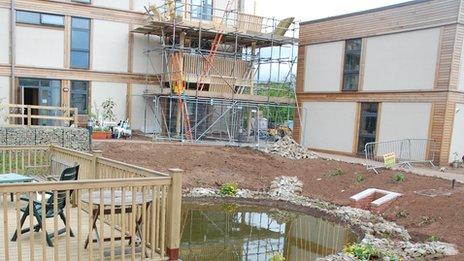Straw bale homes for LILAC co-housing residents
- Published

The homes and common house (on the right) have been built using straw bales as insulation

There are 20 new homes on the site of the former Wyther Park Primary School in Bramley

A decking area next to the common house can be used for outdoor eating in the summer

The group started working on their allotments a year ago and are now growing some of their own food

Contractors will leave the site next week after the remaining work on the car park, landscaping and balconies is complete
One huff and puff was all it took for a wolf to blow down a straw house in The Three Little Pigs.
But construction methods have moved on since the decades-old fairy tale and the use of straw bales as a housing material has become increasingly popular in the UK in recent years.
Straw bale homes are cheaper to build, have a reputation for providing good insulation, are sustainable and tend to be built using locally-sourced materials.
One example of the end product can now be seen in a suburb of Leeds, where residents of what is said to be the UK's first affordable, green co-housing project have finished moving in this week.
LILAC, or Low Impact Living Affordable Community, is a development of 20 homes on the site of the former Wyther Park Primary School in Bramley.
Shared meals
Residents of the now-named Lilac Grove say they are committed to low-impact living, avoiding unnecessary travel and excessive energy use.
Their scheme has been hailed as pioneering, external, not just because of its eco-friendly ethos but because of the way it is financed, external and the fact that it is also based around the Danish co-housing model.
The site sees residents' needs for their own space in private homes mixed with shared facilities in a common house.
Evening meals are shared in the communal space twice a week, laundry facilities are shared in the building and the space is to be regularly used for other get-togethers.
The area around the homes is car-free and largely green space, so Lilac Grove's children can run in and out of each other's homes and play together safely.
Paul Chatterton, one of the founding members of the scheme, is settling in with his partner Tash and son Milo.
He said: "It has been six years and six months since the original idea. To be handed the keys after all these years was a bit surreal.
"The neighbourliness has been unbelievable. It's not even on a level you can compare anything to. The kids are just flourishing.
"One person said 'how could we ever not live like this'. It feels very different but at the same time it feels very natural."
Highs and lows
Groups as nearby as Chapeltown and as far afield as Edinburgh have looked to Lilac Grove for inspiration while coming up with their own schemes.
Mr Chatterton and some of his new neighbours have held workshops to help show others how they could finance and build their own projects.
He said: "Groups doing this have got to prepare themselves for highs and lows. It's not all high points, there's the stress of moving and making sure everybody's getting on.
"We don't want to hold ourselves up as a template because it's not for everyone but there are elements that people can borrow from us. And we are still learning, it's not like we have all the answers."
The UK Cohousing Network, which offers advice and support to new and forming co-housing groups, says there are 15 built communities and more than 40 developing projects in the UK.

A group in Chapeltown are eyeing up this piece of land for a similar scheme
Jo Gooding, from the network, said interest in co-housing was increasing as people became more aware of the concept and sought out affordable homes and a sense of community.
"In the last six months there's been a huge growth," she said.
"We are a small organisation but we have seen an increase in inquiries from individuals and groups who have picked up on stories in the news."
The Chapeltown co-housing group are planning to build a scheme similar to Lilac Grove and hoping to build on soon-to-be-available land off Roundhay Road.
Spokesman Bill Phelps said: "We have had some negotiations with the planners and asset management people, trying to persuade them there's a better use for the local community than just putting another Tesco there.
"Largely Lilac were the inspiration. We had heard about co-housing before but actually seeing a group get off the ground and achieve something made us think we perhaps can do it too.
"One of the trickiest things is ending up with something that's affordable. We don't want to put together a trendy housing scheme in Chapeltown that people living around have no possibility of joining in.
"Community life is a strange concept for a lot of people but we don't want to put more barriers in the way.
"And we don't want it looking like a hippy commune."
- Published1 January 2013
- Published24 November 2012
- Published13 November 2012